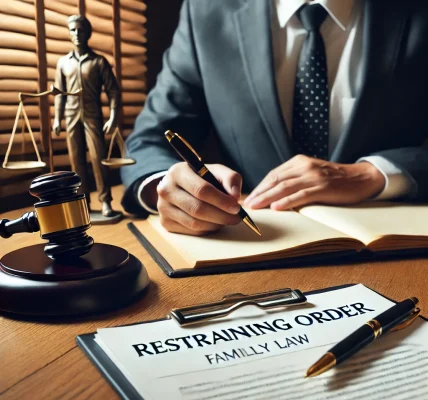Domestic violence is a serious issue that affects countless families worldwide. It can take many forms, including physical abuse, emotional manipulation, financial control, and verbal threats. Family law provides several legal remedies to help victims escape abusive situations and protect themselves and their loved ones.
If you or someone you know is experiencing domestic violence, understanding your legal options is crucial. This guide will provide an in-depth overview of how family law addresses domestic violence, the types of legal protections available, and the steps you can take to secure your safety.
What Is Domestic Violence?
Domestic violence is any form of abuse that occurs within a family or intimate relationship. It can include:
✅ Physical Abuse – Hitting, slapping, pushing, or any form of bodily harm. ✅ Emotional or Psychological Abuse – Manipulation, intimidation, threats, or gaslighting. ✅ Verbal Abuse – Insults, humiliation, or constant criticism. ✅ Sexual Abuse – Any non-consensual sexual act or coercion. ✅ Financial Abuse – Controlling finances, preventing a partner from working, or withholding money. ✅ Stalking and Harassment – Unwanted surveillance, following, or repeated messaging.
Understanding the various forms of domestic violence is essential to recognizing abuse and taking legal action.
Legal Protections Available Under Family Law
Victims of domestic violence have several legal options to seek protection. Here are the primary legal remedies available:
1. Protection or Restraining Orders
A restraining order (also called a protection order) is a legal order issued by a court to protect victims from their abuser. These orders can:
- Prohibit the abuser from contacting or approaching the victim.
- Remove the abuser from a shared residence.
- Prevent the abuser from possessing firearms.
- Establish temporary custody arrangements for children.
There are different types of restraining orders, including emergency, temporary, and permanent orders. The specific process for obtaining one varies by jurisdiction.
2. Filing Criminal Charges
Domestic violence is a criminal offense in many jurisdictions. Victims can file a police report, which may lead to:
- The arrest and prosecution of the abuser.
- Criminal penalties, such as fines or imprisonment.
- Mandatory counseling or rehabilitation programs for the abuser.
Working with law enforcement is crucial in cases where physical harm or severe threats have occurred.
3. Child Custody and Visitation Restrictions
If children are involved, courts may restrict the abusive parent’s access to them. Legal options include:
- Supervised Visitation – The abuser can only visit the child in a supervised setting.
- Termination of Parental Rights – In extreme cases, the court may revoke custody rights.
- Protective Custody Orders – These ensure the child’s safety while legal proceedings are ongoing.
4. Divorce and Separation
If you are married to your abuser, family law allows for legal separation or divorce. Domestic violence can be a factor in:
- Filing for divorce on grounds of abuse.
- Spousal support (alimony) considerations.
- Division of assets to ensure the victim receives fair financial support.
An experienced family law attorney can help navigate the divorce process and secure the best possible outcome.
5. Emergency Shelters and Support Services
Many communities offer domestic violence shelters, which provide a safe place to stay while legal proceedings are underway. These shelters often offer:
- Temporary housing.
- Legal assistance.
- Counseling and therapy.
- Job placement programs.
Steps to Take if You Are Experiencing Domestic Violence
If you are in an abusive situation, follow these steps to protect yourself and your loved ones:
Step 1: Reach Out for Help
- Call 911 or your country’s domestic violence hotline for immediate assistance.
- Contact local shelters or advocacy groups for support.
- Speak with a trusted friend, family member, or therapist about your situation.
Step 2: Document the Abuse
- Keep a journal of incidents, noting dates, times, and descriptions.
- Save text messages, emails, voicemails, and photos of injuries or damaged property.
- Obtain medical records if you seek treatment for injuries.
Step 3: Obtain a Protection Order
- Visit your local family court to file for a temporary restraining order.
- Provide evidence to support your request, such as police reports or witness statements.
- Attend a court hearing for a long-term protective order.
Step 4: Plan a Safe Exit Strategy
- Arrange for temporary housing before leaving.
- Gather important documents (passport, birth certificates, financial records).
- Set up a separate bank account if financial control is an issue.
Step 5: Seek Legal Representation
- Consult a family law attorney specializing in domestic violence cases.
- Explore your options for divorce, custody, and financial support.
- Work with legal aid organizations if you cannot afford a private lawyer.
Which Legal Option Offers the Best Protection?
Choosing the best legal option depends on the severity of the abuse and your specific circumstances:
✅ For Immediate Safety – A protection order provides quick legal protection from further harm. ✅ For Long-Term Security – Filing for divorce and child custody modifications can help sever ties with the abuser. ✅ For Holding the Abuser Accountable – Criminal charges ensure legal consequences for the perpetrator. ✅ For Safe Relocation – Seeking assistance from domestic violence shelters can provide immediate relief.
Conclusion
Domestic violence is a serious issue, but legal protections exist to help victims escape and rebuild their lives. Whether you need a restraining order, custody modifications, or assistance filing criminal charges, understanding your legal rights is the first step toward safety.
Key Takeaways:
✔ Domestic violence can include physical, emotional, financial, and verbal abuse. ✔ Legal remedies such as protection orders and criminal charges help victims secure safety. ✔ Family courts prioritize the best interests of children in domestic violence cases. ✔ Documentation and legal representation are crucial for a strong case. ✔ Seeking help from shelters and advocacy groups can provide immediate protection and resources.
If you or someone you know is experiencing domestic violence, reach out for help today. You are not alone, and legal support is available.
Disclaimer: This article is for informational purposes only and does not constitute legal advice. Please consult a family law attorney for specific guidance.




